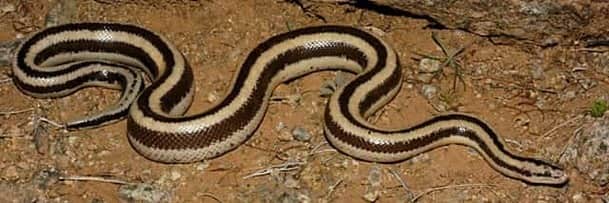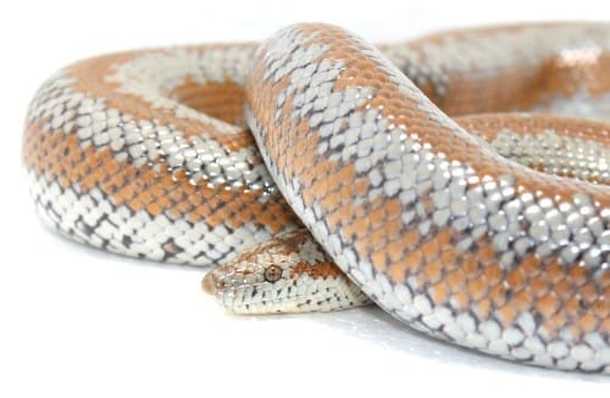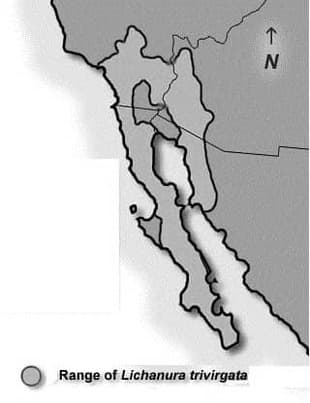Rosy BoaLichanura trivirgata |

Custom Search
|
In Arizona, it's found also in the Mojave Desert and the western regions of the Sonoran Desert. Rosy boas are also found on some offshore islands.
It inhabits anywhere from the low desert basins up to 6000 ft high mountain slopes and can be found in coastal desert canyons, near-desert and desert slopes, rocky shrubland, creek beds, boulder-strewn hillsides. Rosy boas seem to prefer habitats near water sources, but are not restricted to those areas and are rarely found far from rock cover. Rosy boas will spend most of their life concealed in rocky crevices, beneath rocks or in abandoned animal burrows, protected from predators and temperature extremes. Their activity patterns are dependent on weather, in the hot summer months, rosy boas will hunt primarily in the evening and night time, while in the more moderate temperatures it may forage almost any time of day. In most of the rosy boa range, the winter is too cold and they enter a dormant state called brumation, similar to hibernation of mammals. The rosy boa is one of the smallest members of the family Boidae, an adult rosy boa measures only 1/10 of the length of the family's largest member, the green anaconda (Eunectes murinus). These small and very attractive snakes normally reach a length of 17 to 44 inches (43 to 112 cm), with females being somewhat larger than males. An adult rosy boa as a fairly stocky and powerful, muscled body the diameter of a golf ball with smooth scales. They have a stubby short and tapered tail with a blunt tip, that is also slightly prehensile. The head is elongated and only slightly broader then the neck covered with small scales, it has small eyes with vertical elliptical pupils.
Their coloration is highly variable and, usually depends on the geographic location and among the different subspecies. The rosy boa usual pattern consists of 3 dark stripes against a lighter background, one central stripe down the back, and two on the sides. But some specimens lack the obvious striping and are uniformly colored.
The stripes can be irregular or very defined and their color ranges from black or brown to reddish-brown, rust, maroon, orange or even rose. The background color ranges from bluish-gray or gray, tan to yellow, cream or even white. The rubber boa (Charina bottae) is sympatric with the rosy boa in some parts of Southern California and they're sometimes confused. However, the rubber boa differs in the enlarged head scales and are usually uniformly colored, with no striping pattern. The rosy boa average and maximum lifespan in the wild is unknown but average lifespan for captive snakes ranges from 18 to 22 years, although some individuals have been documented to live over 30 years. The rosy boa is considered one of the slowest moving snakes in the world, moving at around 1 mph on open ground. Just compare that to the striking speed of 12 mph (19 km/h) of the highly venomous black mamba, and you see why the mamba as such a fearsome reputation in Africa. Unlike, other snakes like the gopher snake which move forward using an undulating lateral S-shaped movement. The rosy boa moves around mostly using a rectilinear movement, something like a caterpillar (see how do snakes move). When feeling threatened the rosy boa rolls itself into a ball, enveloping its head for protection and leaving its tail exposed and wiggling it as a distraction to the predator. It will also emit an evil-smelling odor from the cloaca. Rosy boas like other snakes have several potential predators including carnivorous mammals such as weasels, skunks, raccoons, ringtails, and coyotes, birds like hawks or shrikes), and even other snakes, such as the California kingsnake. Their common name "rosy" apparently derives from the salmon or pinkish ventral color of some snakes found in the Baja peninsula. But since this is atypical for most individuals, one, somewhat more logical common name. the three-lined boa has also been suggested. Taxonomy / Subspecies Like many other snakes, the taxonomic classification of the rosy boa is under debate 5 or more subspecies proposed. Most scientists agree to separate the rosy boa into 3 recognized subspecies. Although it's very often used especially amongst herpetoculturists, the Mid-Baja Rosy Boa, currently it is not considered a valid subspecies. Mexican Rosy Boa (Lichanura trivirgata trivirgata) - Found in western Sonora in Mexico, north through to the Maricopa Mountains in Arizona and also the southern half of Baja California and surrounding islands. Desert Rosy Boa (Lichanura trivirgata gracia) - Found in the desert mountain ranges of south eastern California and western Arizona. Coastal Rosy Boa (Lichanura trivirgata roseofusca) - Found anywhere from sea level up to 6000 feet (1800 m) from coastal northern Baja north to coastal San Diego and north to the San Gabriel and San Bernardino Mountains. Diet / Feeding
The rosy boa snake feeds primarily on rodents and small mammals like woodrats, deer mice, kangaroo rats and baby rabbits. But they will also prey upon bats, nestling birds, lizards, amphibians and even on other snakes. The rosy boa is an opportunistic feeder, that usually lays in wait for long periods of time, to ambush their prey from a hiding place. But sometimes they will slowly stalk their prey if necessary. Rosy boas are constrictors. They strike the prey and then use it's recurved teeth to get hold of it, at the same time coiling around and constricting it to death. Once dead or incapacitated, the prey is swallowed head first. Sometimes the rosy boa can even capture 2 preys at once, and while one is held wrapped in a coil the other is consumed. Reproduction Male rosy boas unlike other snake species apparently don't engage in competition or fighting for females. The mating season occurs between April and June after they emerging from brumation in the spring, and is also dependent on their geographic location. It's commonly believed that most females breed only once every 2 years. Breeding frequency and success is affected by geographic origin, food availability and other seasonal conditions. The rosy boa is a viviparous snake species, meaning female snakes incubate fertilized eggs inside their bodies. Then after a gestation period that lasts around 3 to 4,5 months (average of 130 days), they give birth to live young between August and November. They are born inside a protective membrane that they split open to free themselves with an egg tooth. The average clutch is about 3 to 8 hatchlings about 18 to 36 cm long, but there can be as low as 1 or as high as 14 neonates. The newborn are similar in appearance to adult snakes both in shape and color patterns, but may have more contrasting patterns with a lighter background or darker stripes. Female rosy boas reach sexual maturity in 2 or 3 years with a length of about 60 cm, while males mature also at 2 to 3 years but with a smaller length of 43 to 58 cm. Conservation / Threats The rosy boa is listed as "Least Concern" by the IUCN Red List. However the U. S. Geological Survey, points out the negative impact from habitat fragmentation, roads and urbanization on the rosy boa populations, even inside natural reserves. The State of California has the species status listed as "sensitive" since 2008. But otherwise, rosy boa populations are considered stable. The species may have to be protected in the future if it is to survive in the long term.
|
Scientific classification |
© 2014 Snake Facts About Us | Privacy Policy | Contact





